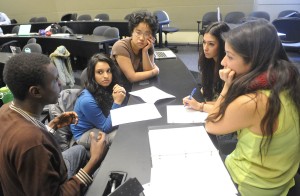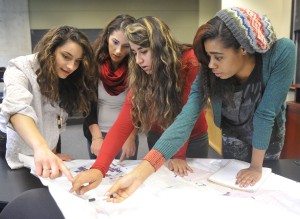
Part Two of “Teaching Culture and Methods to Novice/Non-Anthropologists”
In my last post, I made the case for having students attempt ethnographic papers in courses other than “methods.” By introducing early undergraduates to the pleasures of ethnography, I think we showcase anthropology’s strong suit, but more importantly, I think it is a great way to scaffold them into ways of writing and reading that will serve them well in both the social sciences and the humanities. In this second post, I share the steps I go through to squeeze an ethnographic experience into what are admittedly short, one-term courses (12 weeks). I would love to hear from others who experiment with “hands-on” approaches in sociocultural and linguistic anthropology. Here are my five steps:
1. Explore
Sending students out into the world is less institutionally daunting than it may seem. Course theme and coincidence largely guide my choice as to how to structure where students will do their observations. I generally choose “public spaces” as the ethics approval for these activities is fairly straightforward. I have sent all my students to the same place and have let them choose their own—both ways work. In linguistic anthropology I have them choose a “Community of Practice” which is pretty wide open and can mean anything from drag queens to gym rats. In a third year Politics of Indigeneity course, I had students watch patrons pass through (or not) the Aboriginal Canadian exhibit at the Royal Ontario Museum. This challenges them not to leap to a criticism of the exhibit, but to attend to what happens through it.
2. Gather and Narrow
Once the students find a “there” to be at, I ask them to take field notes. I keep the instructions simple: jot notes in the field, expand notes immediately after, and write a paragraph on what they make of things. There are great sources out there on writing field notes. I don’t use them. My preference is to have students read thematic content, and so I accept that the exercise of writing an ethnographic paper for early undergraduates is an incomplete introduction to fieldwork.
Instead of readings, I show them student samples I find online from similar courses and I share my own field notes. Reading my notes out loud lets students see that while some observations seem like they aren’t about anything, over time they can become the basis of an idea or argument. They also see how my notes sound “like me” and that this is just fine. Many students want to search for an authoritative voice for note taking. Usually this means listing demographic facts in the hopes of sounding thorough or scientific. I try and show them how this leaves little to work with when writing time comes.
I make the case for the old adage “show, don’t tell.” Because I send them out without a firm topic, I warn them that they will feel that their notes are about “nothing.” The trick then is to get down as many telling details as possible. The less they put into the notes the harder it is for me to pull a paper out. First-time ethnographic papers feel a bit like grabbing a rabbit out of a hat—there is some degree of hocus pocus involved.
After one or two visits, depending on the course, there is enough to get us to the next stage—which is narrowing to a topic/theme (the rabbit). I admit this piece is much easier in smaller courses where you can meet one-on-one with students. The hardest part is getting them to see their field site as a window into a debate, and not an exploration of the site for itself. The rabbit goes where it goes and their job is to follow. This usually means a topic they weren’t planning on. These are the best moments if they are open to the chase.
3. Group
Once I see the themes of the papers emerge, I group students into research communities. They almost always cluster well, with only one or two real outliers. In larger classes, I reorganize tutorial groups by these shared interests. If in lecture I ask them to get together to talk or work through a concept or the readings, I ask them to do it in their research communities so that they are dialoguing new information with, and through, their own work/topics.
Their final reading(s) are tailored to their interests, using broad themes like religion, sports, work, gender/sexuality, food, the body, etc. I decide on key article(s) they should read. Sometimes this means asking colleagues (or TAs, if you are lucky to have them). This “open” reading strategy is a gamble, but I get good feedback on the approach. The requirement for the final assignment is to put their field materials into conversation with the targeted reading, and any others from the course. This anchors all the papers in the group to a debate.
4. Revisit
I almost always have them do multiple visits (2-3) because it usually opens up their observation skills and brings in richer data.
5. Write
To get them into the flavor and feel of ethnographic writing, I start one or two classes with free writing exercises geared at getting them to find their voice, or the story they are going to tell. Kirin Narayan’s book Alive in the Writing has great prompts adaptable to student projects. These don’t take long and are a nice break from lecture. I do these exercises along with them so they can see that thoughts wander and some pieces will be good, while others need work—lots of work.
A full-blown paper may not always be the best way to assess what they have learned. It may also be too much work for some courses. I have found a few ways around the “too much” dilemma. For example, in my large linguistic anthropology course, exams are mandatory. I have framed the essay question to be answerable with their collected data. I let them bring in a single page of notes and leave it up to them to decide whether that page has “raw” or “cooked” data (thanks Laura!). This spares them writing an exam separate from a paper, and provides mental relief (for me, too). In a compressed summer course in Women and Gender Studies, where the anthropological approach is new to many students, I elected to have them write extended essay proposals in lieu of papers. Some were taken with the process and elected to write full papers.
When it Works
I have many students who don’t feel entitled to participate in academic debates. Ethnography allows them to enter these debates by starting from a place they feel comfortable—their everyday worlds. Gradually, they learn that theory has to be accountable to the everyday and they start to see themselves as capable interlocutors.
My motivation for organizing courses around mini-ethnographic papers is also partly selfish. It greatly improves the interest factor when marking time comes. The papers aren’t rehearsals of what I have told them in class and always have at least a good anecdote or two. Maybe more importantly, this style of paper asks students to think of themselves as writers/observers and this changes how they approach readings. Not only are they attending to content and argument, but also style and narrative. They start asking how these realms might relate and that’s when things get interesting.
The results are always unexpected. Sometimes these assignments lay the foundation for an interest in graduate work or more research-oriented courses. And sometimes something larger and unexpected unfolds.
Last year, Diana was one of ten young women in my linguistic anthropology course who was looking at service workers as a community of practice. Everyone in the group worked in retail clothing shops to support their studies. As I have an interest in language and work, I led this group’s tutorial. At the outset most said they felt “free” to talk how they wanted. Then as the course progressed and they were introduced to different ideas about language things started to shift. They saw their places of employment differently. They saw talk as “work” and began to describe tensions between scripts managers wanted them to use and notions of forging “genuine” connections to clients in order to make sales. Diana’s story stood out. She zoomed in on newly instituted headsets she and other employees had to wear while working. She observed how conventions of conversation were jeopardized by interruptions over the headset, which clients could often hear. About four months after the course ended, I received this email from her:
I’m not too sure if you remember who I am (I know you have a lot of students), but I’m the girl who wrote about her retail job—Sirens from your ANT206 class. I’m the one that had all the horrible stories about my workplace and the surveillance that we’re put under (headsets). Well, I’m writing to inform you that about a month and a half ago we decided to form a union against the company. It was a long and stressful process, but I can proudly say that we are now the first Sirens unionized in Canada!!
Lindsay A. Bell is a recovering fourth-grade teacher now in the business of teaching Anthropology and Women and Gender Studies at the University of Toronto. In this two-part series, she shares her experiences in putting ethnographic methods and writing at the centre of undergraduate teaching. She teaches in the areas of linguistic anthropology, Indigenous issues, political ecology, gender, and consumer culture. She writes about anthropology, arctic studies, ashtanga yoga, and alliteration. You can find her on Twitter @DrLibertyBell.





